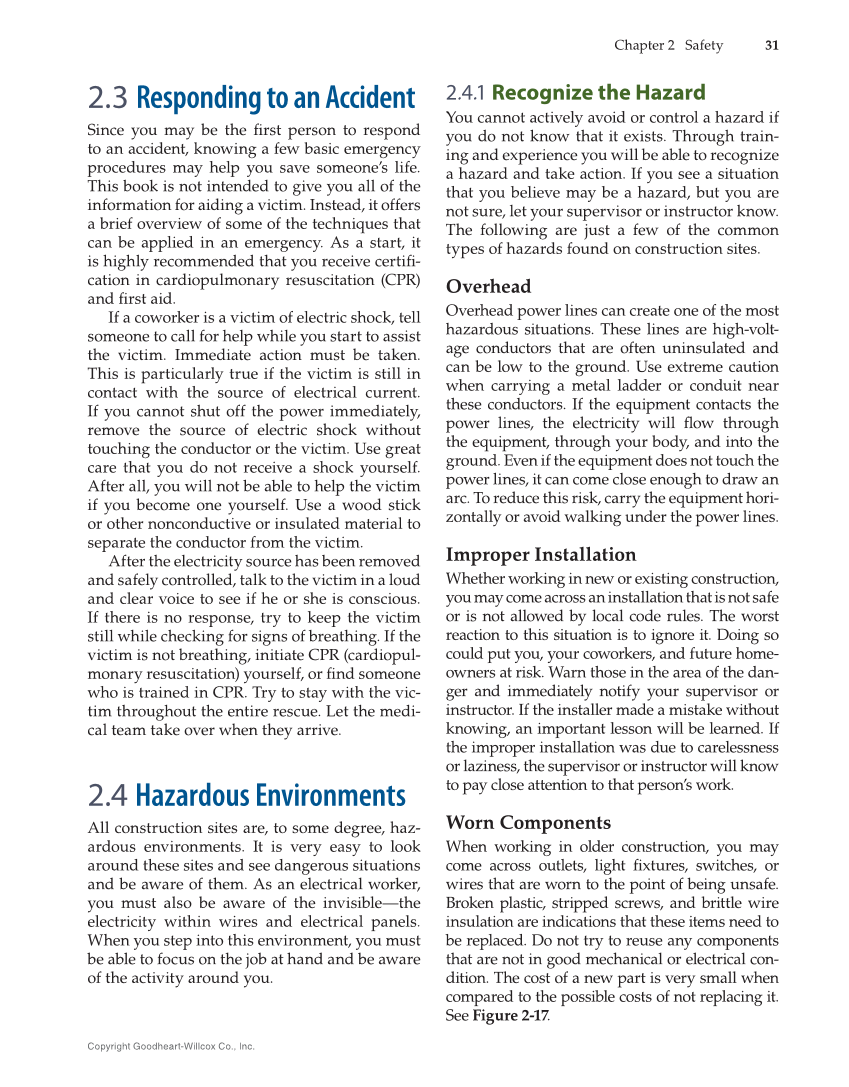Chapter 2 Safety 31 Copyright Goodheart-Willcox Co., Inc. 2.3 Responding to an Accident Since you may be the fi rst person to respond to an accident, knowing a few basic emergency procedures may help you save someone’s life. This book is not intended to give you all of the information for aiding a victim. Instead, it offers a brief overview of some of the techniques that can be applied in an emergency. As a start, it is highly recommended that you receive certifi - cation in cardiopulmonary resuscitation (CPR) and fi rst aid. If a coworker is a victim of electric shock, tell someone to call for help while you start to assist the victim. Immediate action must be taken. This is particularly true if the victim is still in contact with the source of electrical current. If you cannot shut off the power immediately, remove the source of electric shock without touching the conductor or the victim. Use great care that you do not receive a shock yourself. After all, you will not be able to help the victim if you become one yourself. Use a wood stick or other nonconductive or insulated material to separate the conductor from the victim. After the electricity source has been removed and safely controlled, talk to the victim in a loud and clear voice to see if he or she is conscious. If there is no response, try to keep the victim still while checking for signs of breathing. If the victim is not breathing, initiate CPR (cardiopul- monary resuscitation) yourself, or fi nd someone who is trained in CPR. Try to stay with the vic- tim throughout the entire rescue. Let the medi- cal team take over when they arrive. 2.4 Hazardous Environments All construction sites are, to some degree, haz- ardous environments. It is very easy to look around these sites and see dangerous situations and be aware of them. As an electrical worker, you must also be aware of the invisible—the electricity within wires and electrical panels. When you step into this environment, you must be able to focus on the job at hand and be aware of the activity around you. 2.4.1 Recognize the Hazard You cannot actively avoid or control a hazard if you do not know that it exists. Through train- ing and experience you will be able to recognize a hazard and take action. If you see a situation that you believe may be a hazard, but you are not sure, let your supervisor or instructor know. The following are just a few of the common types of hazards found on construction sites. Overhead Overhead power lines can create one of the most hazardous situations. These lines are high-volt- age conductors that are often uninsulated and can be low to the ground. Use extreme caution when carrying a metal ladder or conduit near these conductors. If the equipment contacts the power lines, the electricity will fl ow through the equipment, through your body, and into the ground. Even if the equipment does not touch the power lines, it can come close enough to draw an arc. To reduce this risk, carry the equipment hori- zontally or avoid walking under the power lines. Improper Installation Whether working in new or existing construction, you may come across an installation that is not safe or is not allowed by local code rules. The worst reaction to this situation is to ignore it. Doing so could put you, your coworkers, and future home- owners at risk. Warn those in the area of the dan- ger and immediately notify your supervisor or instructor. If the installer made a mistake without knowing, an important lesson will be learned. If the improper installation was due to carelessness or laziness, the supervisor or instructor will know to pay close attention to that person’s work. Worn Components When working in older construction, you may come across outlets, light fi xtures, switches, or wires that are worn to the point of being unsafe. Broken plastic, stripped screws, and brittle wire insulation are indications that these items need to be replaced. Do not try to reuse any components that are not in good mechanical or electrical con- dition. The cost of a new part is very small when compared to the possible costs of not replacing it. See Figure 2-17.
